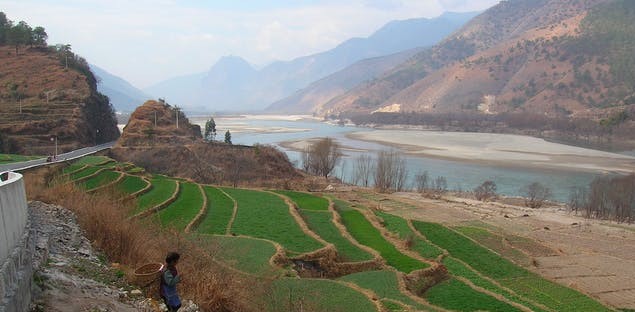Climate Change Impacts of Asian Countries
Asia—not including its western peninsula, Europe, traditionally considered a separate continent for cultural reasons—is the world’s largest continent, with about 4 billion inhabitants. Like all other continents, it is presently experiencing observable effects of anthropogenic (human-caused) climate change and will experience more such effects as global warming continues in the coming decades.
Asia is a vast and diverse landmass, stretching from Siberia in the north, to the Middle East in the west, to the Indian subcontinent in the south, and to China, Southeast Asia, Japan, the Philippines, and Indonesia in the east and southeast. It is difficult to make general statements about Asia regarding climate change or anything else. However, a number of regional impacts have been observed and predicted for the region.
In recent decades, parts of Asia, including India, Korea, and China, have been undergoing unprecedented economic growth. China’s economy, for example, is already
the third-largest in the world and is growing faster than the economy of any other large country. In the first quarter of 2007 alone, China’s economy grew by 11%. At the same time, most of the poor people in the world live in south Asia. In 2007, more than 65% of all people living without sanitation in rural areas, of underweight children, and of people living on less than $1 a day reside in Asia.
All these groups are at greater risk from water stress, increased food costs, and other changes likely to be the indirect result of climate change.
In addition, Asia’s population is growing. From 1995 to 2050, its population is projected to grow by about 2 billion. Poverty, development, and population growth all place stress on the Asian environment and make both that environment and the human societies that depend on it more vulnerable to injury by climate change

ANTHROPOGENIC
Made by people or resulting from human activities. Usually used in the context of emissions that are produced as a result of human activities
GREENHOUSE GASES
Gases that cause Earth to retain more thermal energy by absorbing infrared light emitted by Earth’s surface. The most important greenhouse gases are water vapor, carbon dioxide, methane, nitrous oxide, and various artificial chemicals such as chlorofluorocarbons.
All but the latter are naturally occurring, but human activity over the last several centuries has significantly increased the amounts of carbon dioxide, methane, and nitrous oxide in Earth’s atmosphere, causing global warming and global climate change.
Climate change is already affecting life in Asia. For example, rising temperatures and more frequent extreme weather events have caused crop yields to decline in many Asian countries. Permafrost and glaciers are both retreating in an unprecedented fashion.
Future climate change in Asia will probably affect agriculture and reduce water availability. Compared to 1990 levels, parts of Asia will probably see a 2.5– 10% decrease in crop yields by the 2020s and a 5– 30% decrease by the 2050s. Accelerated melting of glaciers will cause an increase in downstream flooding, but then a decrease in overall flow as the glaciers disappear.
The Himalayan glaciers are receding faster than any others on Earth, and many are very likely to be gone by 2035 or sooner if warming continues at its current rate. If this occurs, rivers on which over half a billion people depend for water will cease to flow for part of the year.
Marine and coastal ecosystems will probably be affected by sea-level rise and warming. Human settlements will likely be affected, with a million people along the coasts of south and Southeast Asia at increased risk from flooding.
In large river deltas, which are flat and densely populated, flooding of land by rising ocean waters will affect aquaculture and endanger infrastructure (roads, buildings, bridges, etc.). Between 24% and 30% of the coral reefs of Asia are likely to disappear in the next 10 to 30 years.

Future climate change in Asia will probably cause human health to deteriorate. In south and Southeast Asia, increased rates of illness and death from diarrhea are likely to increase. (Diarrhea now causes about 4% of all deaths, globally, each year; the percentage is higher in Asia and Africa.) Also, the habitats for disease vectors (insects or other animals that spread diseases) will likely expand in north Asia.
Various environmental problems will be made worse by climate change. As in Africa, Asia’s environment is presently being stressed by a number of problems, including population growth, the vast expanse of cities, and the rapid growth of industry and industrial pollution. Climate change makes it more difficult to sustain these processes or to reduce the damage they cause.
For example, rapid industrialization in China is causing that country to open about one new coal-fired electricity-generating plant each week, accelerating global warming and contributing to the deaths of many of the 650,000 people who die every year in China from diseases associated with air pollution.
China and India are the largest countries in the world, with over 1 billion inhabitants each. Both are rapidly industrializing, leading them to rapidly increase the amount of greenhouse gases they emit and causing great hardship to poor rural populations. In 2007, China became the world’s largest emitter of greenhouse gases, surpassing the United States.
According to the IPCC, sustainable development policies would likely reduce pressure on natural resources in Asia and make it easier to adapt to global warming. Such measures would include:
1) government policies against diverting land from agriculture even when it becomes more profitable to devote that land to industry, as such diversion can undermine food production;
2) sustainable forestry practices
3) increased efficiency of energy use for various purposes
4) generation of energy by non-greenhouse-polluting methods such as wind mills, and more
reference -encyclopedia site
